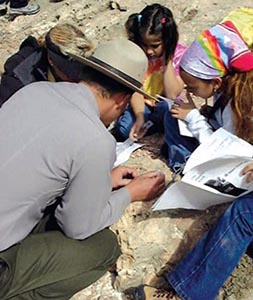
Audubon Adventures
Respect Nature as You Study It
To Collect or Not To Collect
People often collect items from nature out of fascination, curiosity, and appreciation for their beauty. Classroom collections of leaves, shells, stones, and other natural items seem like obvious learning opportunities. But collecting and displaying natural materials raises issues for you and your students to consider in relation to your ongoing studies in nature.
 All things in an ecosystem have roles to play in keeping the system healthy, and living systems depend on reusing organic material in a variety of ways. Look for opportunities to discuss this interdependence and “natural recycling plan” with your students. Ask them to think about and discuss the consequences when people disrupt these systems. Does it do any harm when one person takes one plant (for example)? What about when one hundred people each take one plant? How can one person who collects one plant be sure that a whole bunch of other people aren’t doing the same? What’s the solution to that problem?
All things in an ecosystem have roles to play in keeping the system healthy, and living systems depend on reusing organic material in a variety of ways. Look for opportunities to discuss this interdependence and “natural recycling plan” with your students. Ask them to think about and discuss the consequences when people disrupt these systems. Does it do any harm when one person takes one plant (for example)? What about when one hundred people each take one plant? How can one person who collects one plant be sure that a whole bunch of other people aren’t doing the same? What’s the solution to that problem?
Ask the class to brainstorm about ways to study and enjoy natural materials without harming the ecosystem—for example, making, collecting, and displaying photographs; learning proper collecting techniques and restricting a collection to one example of each type; getting materials from science-supply companies; collecting things to study for a short time and then returning them to where they were found. On nature walks and field trips, ask students to try to figure out how different things (living and nonliving) in the natural environment depend on one another. Draw their attention to evidence of nature’s recycling plan.
Here are some items from nature that people like to collect and some points to consider in discussing them with your students
Birds’ nests and feathers; snake skins
Birds sometimes reuse a nest, or other birds use its building materials to make their own nests. Some birds also use feathers and snake skins as nest-building material.The Migratory Bird Treaty Act makes it “unlawful to . . . possess . . . any migratory bird, part, nest, egg, or product . ..”
Flowers, plants, and leaves
People grow flowers, trees, and other plants in their homes and yards in order to experience the beauty and pleasure of nature at work. But taking plants, flowers, and even leaves from natural places such as roadsides, parks, and forests removes them from their place in the ecosystem.They provide food and shelter for small organisms and in the process are recycled as they decompose, eventually enriching the soil.
Live animals, such as frogs, toads, spiders, insects, turtles, fish, and worms
Collecting live animals from nature threatens both the ecosystem and the animals. If an animal is ever captured for short-term study, it must be handled with extreme care and returned to the place where it was found.




